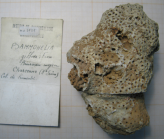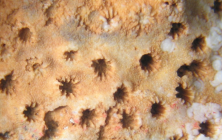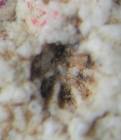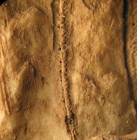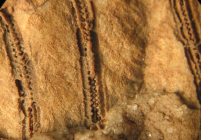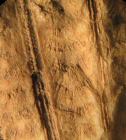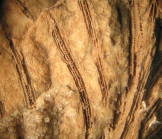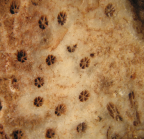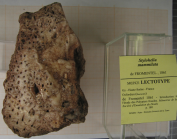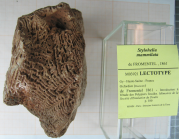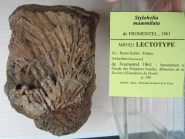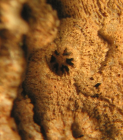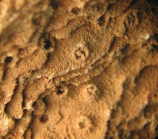Scleractinia taxon details
Stylohelia de Fromentel, 1861 †
1438327 (urn:lsid:marinespecies.org:taxname:1438327)
accepted
Genus
Psammohelia de Fromentel, 1861 † · unaccepted > junior subjective synonym
- Species Stylohelia costulata (Koby, 1881) †
- Species Stylohelia mammilata de Fromentel, 1861 †
- Species Stylohelia mamillata Fromentel, 1861 † accepted as Stylohelia mammilata de Fromentel, 1861 † (unaccepted > misspelling - incorrect subsequent spelling)
marine, fresh, terrestrial
fossil only
Fromentel, E. de. (1861). Introduction a l'etude des polypiers fossiles. <em>Memoires de la Societe d 'Emulation du Departement du Doubs.</em> 1-157. [details]
Description Massive hummocky plocoid corallum with a wide peritheca. The axis of hummocks is occupied by an axial corallite. Other...
Description Massive hummocky plocoid corallum with a wide peritheca. The axis of hummocks is occupied by an axial corallite. Other corallite appear near this corallite and radiate from there but the increase is extracalicular. The calicular longitudinal profile is vertical near the inner edge of the wall and horizontal in the calicular floor. Circular corallites in relief like small volcanoes. Epitheca not observed. Peritheca exclusively made of trabecular tissue (no exotheca preserved on the lectotype). These trabecules constitute very thin costae, they are arranged perpendicularly to the distal surface of peritheca, which is concave upward. So, within a costa, trabecules converge upward. Radial elements are compact straight costosepta. First cycle regularly anastomosed to the columella, other cycle free and often attenuated. Hexameral septal apparatus with a predominant radial symmetry. Lateral faces poorly ornamented. Inner edges of major septa with periodical auriculae. Septal trabecules diverging upward in the septal plan. Styliform columella very regularly connected to major septa by connecting rods. Endotheca made of regularly spaced tabulae. Synapticule-like structures regularly connect the very thin costae in the peritheca. The wall is etallonothecal. One septum corresponds to several rows of granules. [details]
Hoeksema, B. W.; Cairns, S. (2024). World List of Scleractinia. Stylohelia de Fromentel, 1861 †. Accessed at: https://marinespecies.org/scleractinia/aphia.php?p=taxdetails&id=1438327 on 2024-05-07
Date
action
by
original description
Fromentel, E. de. (1861). Introduction a l'etude des polypiers fossiles. <em>Memoires de la Societe d 'Emulation du Departement du Doubs.</em> 1-157. [details]
original description (of Psammohelia de Fromentel, 1861 †) Fromentel, E. de. (1861). Introduction a l'etude des polypiers fossiles. <em>Memoires de la Societe d 'Emulation du Departement du Doubs.</em> 1-157. [details]
additional source Duncan PM (1884) A revision of the families and genera of the sclerodermic Zoantharia, Ed. & H., or Madreporaria (M. Rugosa excepted). Journal of the Linnean Society of London, 18: 1-204. [details]
additional source Beauvais L, Beauvais M. (1975). Une nouvelle famille dans le sous-ordre des Stylinida Alloiteau: les Agatheliidae nov. fam. (Madréporaires mésozoïques). <em>Bulletin de la Société Géologique de France, 7e série.</em> 17: 576-581. [details]
original description (of Psammohelia de Fromentel, 1861 †) Fromentel, E. de. (1861). Introduction a l'etude des polypiers fossiles. <em>Memoires de la Societe d 'Emulation du Departement du Doubs.</em> 1-157. [details]
additional source Duncan PM (1884) A revision of the families and genera of the sclerodermic Zoantharia, Ed. & H., or Madreporaria (M. Rugosa excepted). Journal of the Linnean Society of London, 18: 1-204. [details]
additional source Beauvais L, Beauvais M. (1975). Une nouvelle famille dans le sous-ordre des Stylinida Alloiteau: les Agatheliidae nov. fam. (Madréporaires mésozoïques). <em>Bulletin de la Société Géologique de France, 7e série.</em> 17: 576-581. [details]
 Present
Present  Inaccurate
Inaccurate  Introduced: alien
Introduced: alien  Containing type locality
Containing type locality
From editor or global species database
Description Massive hummocky plocoid corallum with a wide peritheca. The axis of hummocks is occupied by an axial corallite. Other corallite appear near this corallite and radiate from there but the increase is extracalicular. The calicular longitudinal profile is vertical near the inner edge of the wall and horizontal in the calicular floor. Circular corallites in relief like small volcanoes. Epitheca not observed. Peritheca exclusively made of trabecular tissue (no exotheca preserved on the lectotype). These trabecules constitute very thin costae, they are arranged perpendicularly to the distal surface of peritheca, which is concave upward. So, within a costa, trabecules converge upward. Radial elements are compact straight costosepta. First cycle regularly anastomosed to the columella, other cycle free and often attenuated. Hexameral septal apparatus with a predominant radial symmetry. Lateral faces poorly ornamented. Inner edges of major septa with periodical auriculae. Septal trabecules diverging upward in the septal plan. Styliform columella very regularly connected to major septa by connecting rods. Endotheca made of regularly spaced tabulae. Synapticule-like structures regularly connect the very thin costae in the peritheca. The wall is etallonothecal. One septum corresponds to several rows of granules. [details]Remark The genus can be interpreted contradictorily as a junior synonym of Heliocoenia (Zaman 2012) or a valid genus characterised by the wide space between corallites, the synapticules-like structures in the peritheca and possibly the dominance of trabecular tissues in the peritheca. Four nominal species are reported in Jurassic and four others in the Cretaceous (Löser 2000) [details]
